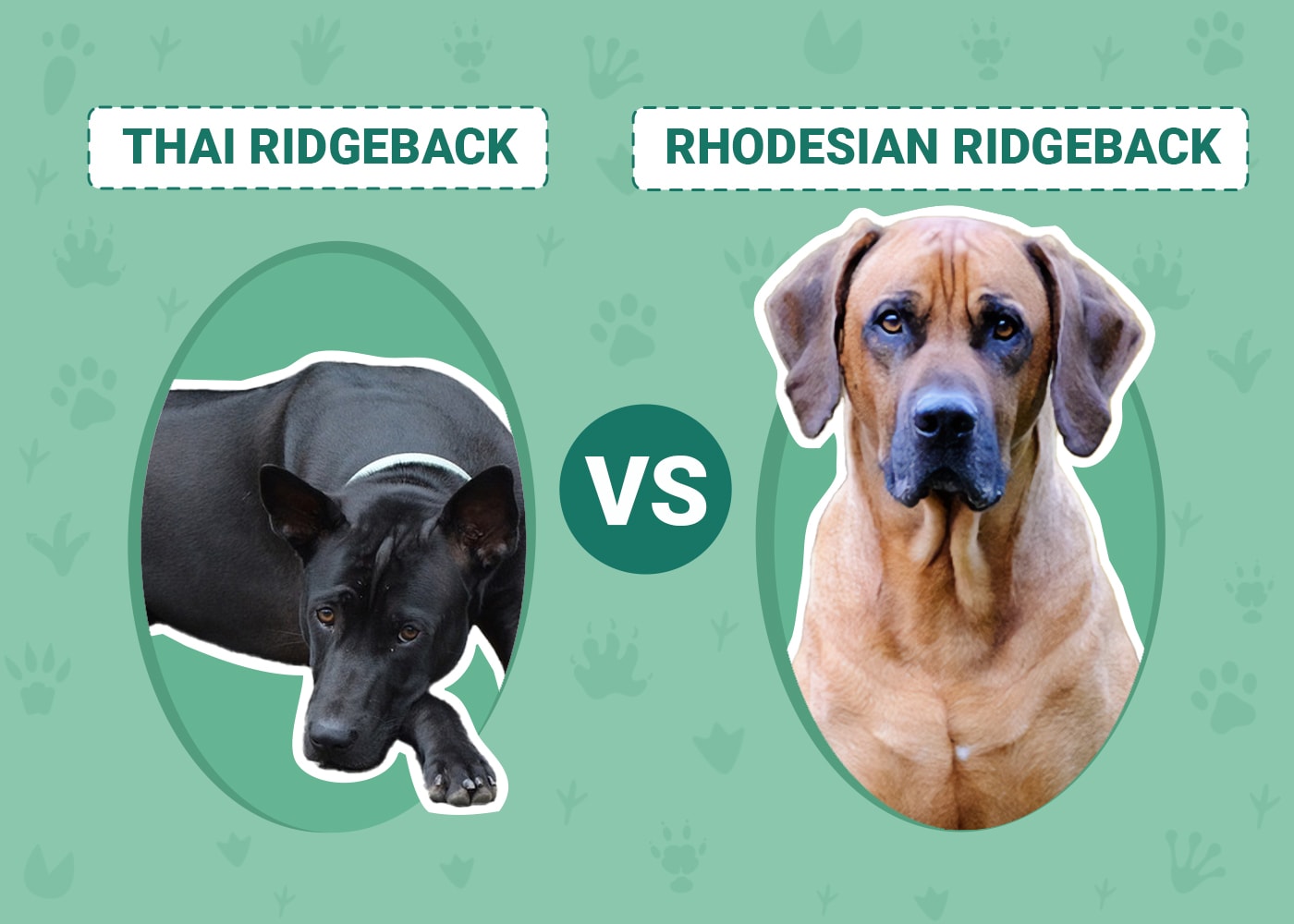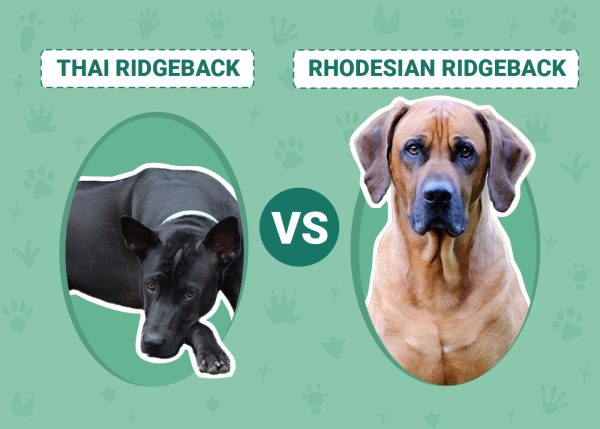The Thai Ridgeback and the Rhodesian Ridgeback are two dog breeds that get their name from their distinct ridge of hair growing in the opposite direction. With their strong, primitive instincts and their muscular and menacing build, these Ridgebacks can be intimidating to most people. Despite this, they are incredibly loyal and affectionate dogs that have high levels of energy and athleticism.
Both these Ridgebacks are two of lesser-known breeds— the Thai Ridgeback being a medium-size breed, and the Rhodesian Ridgeback being a large breed. Despite being uncommon, these dogs make great family pets and reliable guard dogs. Sharing similarities as fellow Ridgeback breeds, you may be surprised that the two differ in many ways. For instance, the Thai Ridgeback belongs to the companion breed group, while the Rhodesian Ridgeback belongs to the hound breed group.
Aside from their breed groups, the Thai and Rhodesian Ridgeback also differs in origin, size, temperament, training, and appearance. Read on to understand more about the comparison between these two Ridgebacks!
Visual Difference
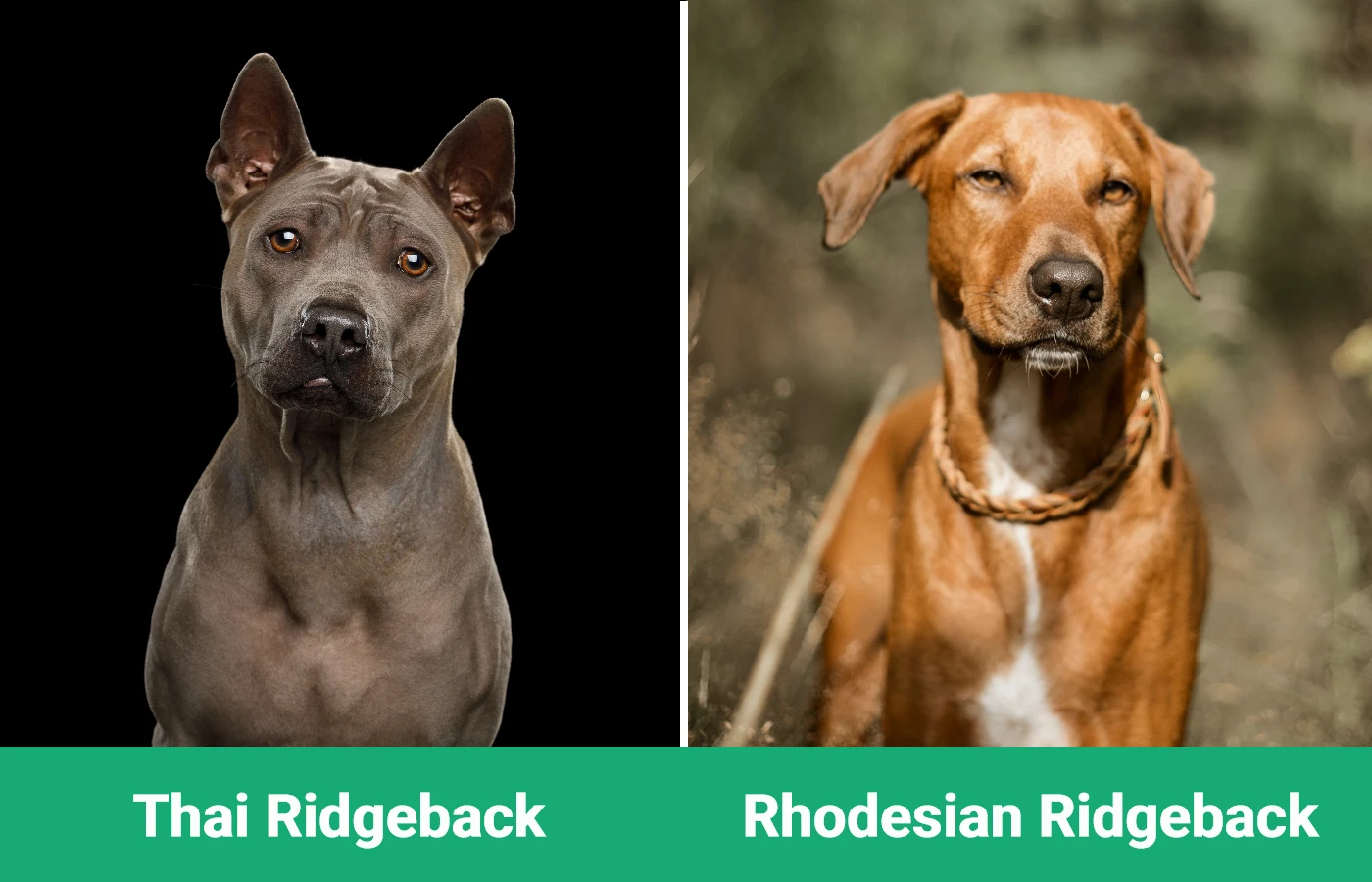
At a Glance
- Average height (adult): 20 to 24 inches
- Average weight (adult): 35 to 75 pounds
- Lifespan: 10 to 13 years
- Exercise: 30 minutes to one hour a day
- Grooming needs: Moderate
- Family-friendly: Yes
- Other pet-friendly: Often with proper socialization
- Trainability: Intelligent, loyal, eager to please, independent
- Breed Group: Companion Group
- Average height (adult): 24 to 27 inches
- Average weight (adult): 70 to 85 pounds
- Lifespan: 10 to 13 years
- Exercise: 30 minutes to 1 hour a day
- Grooming needs: Minimal
- Family-friendly: Yes
- Other pet-friendly: Often with proper socialization
- Trainability: Intelligent, loyal, willful, independent
- Breed Group: Hound Group
Thai Ridgeback Overview
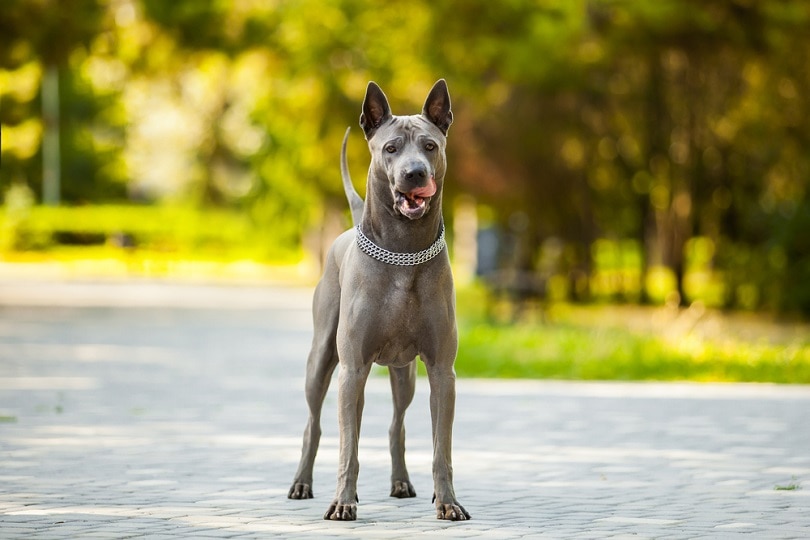
Also known as pariah dogs, the Thai Ridgeback is an athletic and muscular medium-sized breed that originated in Thailand. This energetic and primitive breed was mainly bred to be hunting dogs in Eastern Thailand during the 1600s. Aside from hunting, they were also primarily bred for pulling and escorting carts in the region as watch dogs.
Throughout the years, the Thai Ridgeback has kept its pure-bred, original type. This is because cross breeding of this breed was both uncommon and unlikely due to the poor transportation system and remoteness of the region. Due to the harsh living conditions, they adapted to become independent, self-sufficient, and resourceful in order to survive.
Today, Thai Ridgebacks have proven to be excellent family dogs, exhibiting affection and loyalty toward their owners. The Thai Ridgeback is now mainly bred for companionship, but still possesses the same high intelligence and strong instincts that allowed them to survive all those years ago.
To this day, the Thai Ridgeback is still considered rare outside of Thailand. They may not be as popular as other medium-sized companion dogs, but they definitely make excellent family dogs with their admirable traits. They are protective of their families, incredibly loyal, and show tons of affection!
Physical Appearance
Thai Ridgebacks are smaller than their Rhodesian counterparts, standing at an athletic 20 to 24 inches and weighing between 35 to 75 pounds. Coming from a tropical climate, the Thai Ridgeback has a short coat that requires weekly brushing to keep healthy. Their coats generally come in solid colors, such as black, blue, red, or fawn. Some Thai Ridgebacks may have bridle and white coats, but these color coats are not recognized as breed standard.
The Thai Ridgeback has eight distinctive ridge patterns, such as feather, needle, violin, lute, lead, saddleback, and bowling pin. Thai Ridgeback pups can be born with or without the ridge, but will eventually develop it as they grow older.

Personality & Temperament
The Thai Ridgeback is a loyal and affectionate companion dog. They are loving and enjoy the company of their humans, and are even tolerable of small children. With their primitive instincts, they are naturally protective and may be wary and cautious towards strangers. They are vigilant and constantly on their toes for danger.
They also have a higher prey drive, which makes it risky to leave your Thai Ridgeback unleashed in public. You may find your Thai Ridgeback chasing small animals, such as cats, rabbits, and squirrels. They generally get along with other pets, but may have a tendency to exhibit aggression toward smaller animals, like cats—so proper exposure is important during puppyhood.
Thai Ridgebacks were built for companionship, so it is best to shower your Thai Ridgeback with a lot of attention. These dogs are also known to exhibit destructive behaviors when not properly stimulated, so be prepared to spend lots of time with your dog.
Training
To control their overprotectiveness, high prey drive, and primitive instincts, early training and socialization is important. Be sure to expose your Thai Ridgeback to strangers and other animals early on to manage their strong primitive instincts and reserved nature toward strangers.
The Thai Ridgeback is an intelligent and stubborn dog, so a firm and steady hand is needed when training this dog. Training the Thai Ridgeback requires patience, but early and continuous training can make the Thai Ridgeback the perfect family dog.

Health & Lifespan
The Thai Ridgeback is a generally healthy breed, with an average lifespan of 10 to 13 years. Like most breeds, they are also susceptible to certain health conditions, such as dermoid sinus and hip dysplasia.
As robust and healthy breeds, proper exercise of 30 minutes to one hour a day is necessary to keep them fit and burn energy. A healthy and balanced diet is also a must, along with consistent check-ups with the veterinarian.
Suitable for:
The Thai Ridgeback is suitable for active families with experience owning and training dogs. They are loving and tolerable of children, but due to their size, they may not be suitable for smaller children to avoid any accidents. They work well for households with other dogs, but require early socialization and training to control their elevated prey drive.
Rhodesian Ridgeback Overview

Another dog among the Ridgeback breeds, the Rhodesian Ridgeback is an interesting product of Rhodesia in Zimbabwe, South Africa. This unique breed of dog resulted from the cross between the ridged Khoikhoi dog native to the region and Boer Dogs, Greyhounds, and various terriers during the late 19th century.
Historically, the Rhodesian Ridgeback showed prowess and reliability in hunting lions through harrying, giving them the nickname, “the African Lion Hound”. Aside from their proficiency as hunting dogs, they were also used as guard dogs to repel other dangerous animals, such as leopards and baboons. They also showed extreme athleticism, able to keep up with horse-mounted riders. They were primarily used as hunting and guard dogs in the rough South African Terrain, but were also recognized for their affection and loyalty toward their families.
With big-game hunting slowly fading in South Africa, the Rhodesian Ridgeback faced extinction. They were eventually saved and bred primarily for companionship and family life. Under the hound category, Rhodesian Ridgebacks still have their primitive instincts and increased prey drive, but remain excellent family dogs with their devotion and affection.
Physical Appearance
The Rhodesian Ridgeback is slightly bigger than its Thai counterpart at 24 to 27 inches in height, and 70 to 85 pounds in weight. They also have a short-haired coat that can easily be maintained through weekly brushing, but do tend to shed much less than their Thai cousins. Unlike the Thai Ridgeback, however, they only have one color of coat of wheaten, which comes in various shades.
The ridge on the Rhodesian Ridgeback is clearly defined and symmetrical throughout the dog’s back. The ridge begins immediately behind the shoulders, which symmetrically continues all the way down to the prominence of both hips. These two whorls, or crowns, at the end of the ridge are distinct and symmetrically opposite one another.
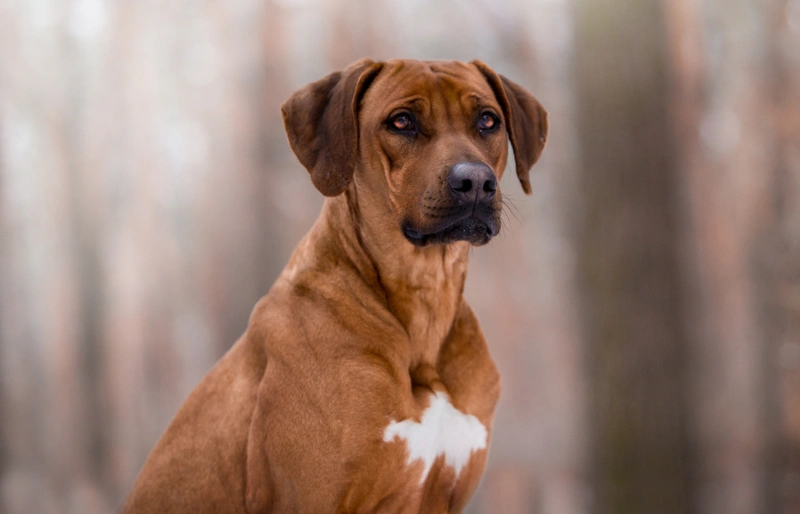
Personality & Temperament
With the proper training and socialization, Rhodesian Ridgebacks are gentle and affectionate dogs. They are loyal and protective, constantly looking after their families and reserved toward strangers. They also have a higher prey drive like the Thai Ridgeback, and are quick to lunge and chase smaller animals. They are also known to work well with other animals, especially if they grew up with them during puppyhood.
They work great with children and are naturally protective and tolerable toward them. Because of the Rhodesian’s size and energy, they may not be suitable for smaller children. Although gentle, children must also be taught how to respect the Rhodesian Ridgeback to prevent any unwanted accidents.
Training
Rhodesian Ridgebacks are much more stubborn than their Thai counterparts, requiring a more competent and strong hand to train. They are intelligent and highly trainable, but need patience and continuous training throughout their lives.
Early socialization and training is necessary for them to grow into well-rounded dogs. They require exposure to strangers, other animals, and different environments.

Health & Lifespan
The Rhodesian Ridgeback can live up to 10 to 13 years. They are also generally healthy dogs, but may also suffer similar conditions as their Thai cousins, such as dermoid sinus and hip dysplasia. In addition, they are also known to have elbow dysplasia and hypothyroidism.
Like the Thai Ridgeback, along with a healthy diet, they need 30 minutes to one hour of exercise per day to stay fit and properly stimulated enough to prevent destructive behaviors and health complications.
Suitable for:
The Rhodesian Ridgebacks are not suitable for inexperienced or novice dog owners because of their stubbornness. Instead, they are suitable for active families that can take the time to train and spend time with their dogs. They are affectionate and lovable dogs that can also make great watchdogs.
They are also suitable for families with older children and multi-pet households, provided they are properly socialized and exposed at a young age.
Which Breed Is Right for You?
The Thai Ridgeback and Rhodesian Ridgeback are two beautiful and unique dog breeds that make excellent family dogs.
The slightly smaller Thai Ridgeback’s temperament comes from its history of survival in harsh conditions in Eastern Thailand, while the larger Rhodesian Ridgeback temperament comes from their heavy utilization as both hunting and guard dogs in the rough South African environment. The two breeds have similar temperaments—with the Rhodesian being slightly more stubborn and willful than the Thai. Both require a strong and firm hand for training due to their high intelligence and primitive instincts.
Despite these slight differences, properly trained and socialized Thai and Rhodesian Ridgebacks make excellent family dogs and companions that are protective, loyal, affectionate, and lovable!
See also:
- How Much Does a Thai Ridgeback Dog Cost? (Price Guide)
- Are Rhodesian Ridgebacks Aggressive? Facts & FAQ
Featured Image Credit: Top – Thai Ridgeback (Dmytro, Shutterstock) | Bottom – Rhodesian Ridgeback (Couleur, Pixabay)

